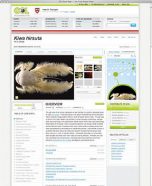The Book of Life
Work has begun on a Web site called the Encyclopedia of Life, which aims to catalog every species on Earth.
By Emily Sohn
So far, scientists have named about 1.8 million living species, and that’s just a fraction of what probably exists on Earth. With so many plants, animals, fungi, and other organisms covering the planet, it can be tough to figure out what type of spider is crawling up your leg or what kind of bird just flew by.
A soon-to-be-launched Web site might help. An international team of researchers has announced the creation of a Web-based Encyclopedia of Life (EoL). The project aims to catalog every species on Earth in a single, easy-to-use reference guide.
 |
|
A sample page from the Encyclopedia of Life enables people to read about the recently discovered Yeti crab. Eventually, readers will be able to add comments pages such as this one.
|
| Encyclopedia of Life |
To get the encyclopedia started, the creators will use information from scientific databases that already exist. And eventually, in special sections of the site, nonscientists with specialized knowledge will get to chime in. Gardeners, for example, will be able to record the dates that their flowers first bloom each year. Bird-watchers will be able to input which birds they’ve seen and where. The technology for this kind of tool has only recently become available.
As the EoL develops, you might find it useful for school projects. The site will feature special pages for kids who are studying ecosystems in their neighborhoods. To make sure the encyclopedia is accurate, scientists will review much of the information added to it. People who visit the site will be able to choose to skip pages that haven’t been reviewed.
Another convenient feature of the EoL is that you’ll be able to pick the level of detail you see to match your interests, age, and current knowledge. If you wanted to learn about polar bears for a science class report, for example, you could use the “novice” setting to get basic information about the animals. On the “expert” setting, on the other hand, you could get much more detailed information about the history, literature, and exploration of polar bears.
It now takes years for scientists to collect all the data they need to describe and analyze species. The creators of the Encyclopedia of Life hope that their new tool will speed that process.
Keep an eye on www.eol.org. Pages will begin to go up sometime next year, and you might find them useful for your school reports. The EoL team might have the basics for all 1.8 million entries online as early as 2017. Someday, you might add your own notes.—Emily Sohn
Going Deeper:
Milius, Susan. 2007. Extreme encyclopedia: Every living thing will get its own page. Science News 171(May 12):294. Available at http://www.sciencenews.org/articles/20070512/fob7.asp .
Sohn, Emily. 2005. Nature’s alphabet. Science News for Kids (Nov. 16). Available at http://www.sciencenewsforkids.org/articles/20051116/Feature1.asp .







